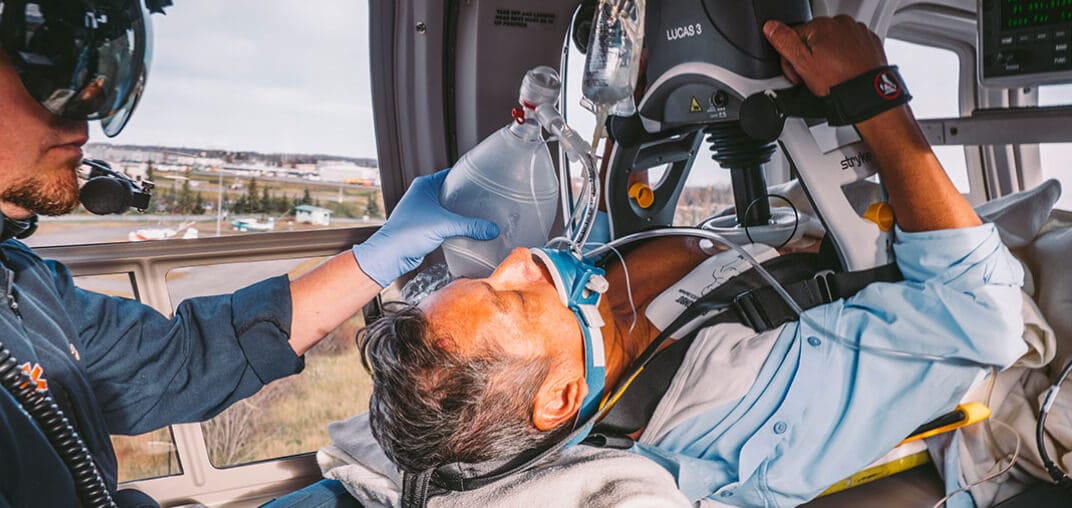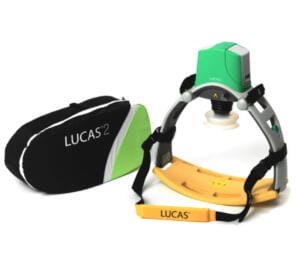The Lucas Device Explained

Today we are going to discuss the Lucas 2 (Chest Compression System). The Lucas 2 is an automated compression device that allows for you to be able to do consistent and high quality compressions. High quality CPR compressions are imperative for good survival outcomes in patients.
What’s included with the Lucas
First, let’s explain what the Lucas 2 consists of. When you open it up, then the first thing you will find is the backboard. The backboard has a curvature to it so it fits nicely against the back of the patient. Then you also have the actual device that does the compressions. It has an arch form, and a suction cup with a piston.
The Lucas 2 does a piston-like motion, as if you were doing manual CPR. The device has a few controls: an on Button, a play button, and it another play button that allows for the compressions to be done in the ratio of 30 to 2. In this mode the device will do 30 compressions, then pause for a few seconds to let you give two breaths.
You will see the Velcro straps on the side- these are to be able to keep the patient’s wrists out of the way. As you are moving the patient, either onto the cot or just in general, it prevents their extremities from being able to move around.
How Does it Work?
Here is how to actually use the Lucas: Let’s say you have a patient who you have determined is unresponsive and has no pulse. You are going to lift them up and slide the backboard underneath them. Then the backboard is going to be positioned right underneath the shoulder blades or right under the armpits. Next, you will immediately turn your Lucas on. You will take it and it will clip into the backboard on the other side. Then, you will lower the piston down over the bottom half of the victims breastbone. Once it is in place you will press the play button and it will begin doing compressions.
There is a mechanism within the Lucas that allows for it to measure the resistance of a person’s chest. The muscle and bone structure of a person are attributes that will make a person’s chest more or less resistant and difficult to compress. The Lucas is able to actually measure that resistance then output the proper amount of force needed to get that two inches of depth.
That’s the Lucas 2. It has fantastic results and outcomes for patients. The consistency and the quality of compressions are obvious. What is great about it is that you do not have to worry about compressions being stopped or paused. Compressions continually being performed at the proper rate, proper depth, and proper quality- That is the Lucas 2.
Who is the LUCAS device for?
The Lucas device is ideal for First Response Teams. These are usually stocked on ambulances, fire trucks, life flights, and sometimes first responder trucks. They are also used in hospitals but it is not as common. Hospitals usually have a fully staffed ‘code team’ and have the advantage of many hands to help ventilate, compress, and use an AED on an unresponsive patient.
Many hospitals have seen the Lucas as opportunity to save on staffing costs and have supplied them for their staff. The Lucas Device has also been proven to increase (ROSC) return of spontaneous circulation by 15% in the ER, which is a significant increase.
However, the Lucas Device often goes unused and has not been as widely accepted in the hospital setting. The phrase ‘you can’t teach an old dog new tricks’ is commonly thrown around in the medical field. While our understanding of best practices is always changing, many workers in the medical field are worn out by constant changes and want to practice what they are comfortable with.
Meanwhile, on an ambulance and EMT is able to drive the truck while the paramedic secures the Lucas device to automate compressions and then continue to focus on giving ventilations and using an automated external defibrillator.
Because the average response time for emergency services is usually no longer than 7 minutes, Lucas devices are generally not recommended for non-emergency services, schools, nursing facilities, etc.
How much is the Lucas Device?
You can buy a new Lucas device for around $17,000. You can also find refurbished Lucas Devices that are discounted to around $10,000 k.
The Lucas Device is high on any fire departments wishlist that doesn’t have one. Another product that is set next to the Lucas Device on that Christmas list is the Defibtech Lifeline View AED. This AED retails at $1,820 and is another indispensable life saving device for first response teams. With an easy to use design, it’s easy to quickly deliver a shock to patients that need it. Defibrillation within the first few minutes of having a Sudden Cardiac Arrest, increases the chance of survival, to over 70%.
How Can I Purchase a Lucas Device?
Although the device is not advertised on their website, CPR Supply Source can distribute a Lucas Device to your organization. Contact [email protected] directly for a quote.


